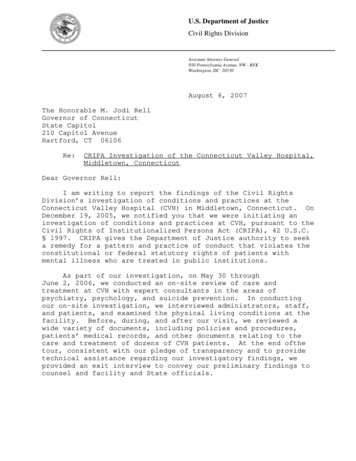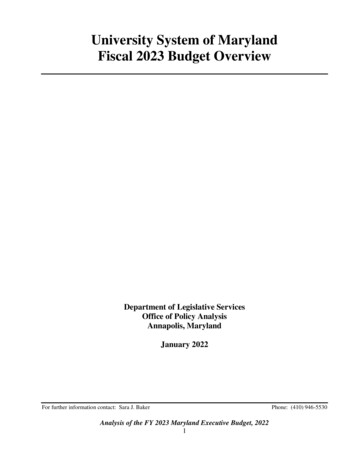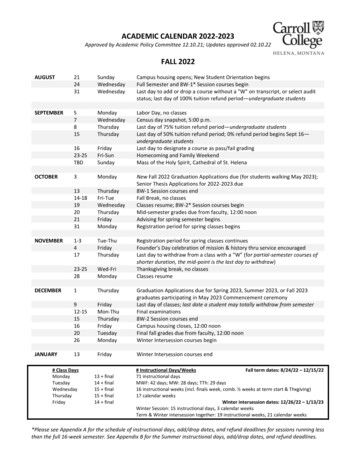
Transcription
CONNECTICUT PYS 2020-2023
CONTENTSConnecticut PYs 2020-2023 . 1I. WIOA State Plan Type and Executive Summary . 3a. WIOA State Plan Type. 3b. Plan Introduction or Executive Summary . 3II. Strategic Elements . 5a. Economic, Workforce, and Workforce Development Activities Analysis . 5b. State Strategic Vision and Goals . 30c. State Strategy . 42III. Operational Planning Elements . 51a. State Strategy Implementation . 51IV. Coordination with State Plan Programs . 140V. Common Assurances (For All Core Programs) . 141VI. Program-Specific Requirements for Core Programs . 142Program-specific Requirements for Adult, Dislocated Worker, and Youth Activities underTitle I-B . 142Program-Specific Requirements for Wagner-Peyser Program (Employment Services) . 161Program-specific Requirements for Adult Education and Family Literacy Act Programs . 193Program-Specific Requirements for Vocational Rehabilitation (Combined or General) . 210Program-Specific Requirements for Vocational Rehabilitation (Blind). 260VII. Program-Specific Requirements for Combined State Plan Partner Programs . 316Performance Indicator Appendix . 317Other Appendices. 317Page 2
I. WIOA STATE PLAN TYPE AND EXECUTIVE SUMMARYA. WIOA STATE PLAN TYPEThis is a unified planB. PLAN INTRODUCTION OR EXECUTIVE SUMMARYThe State of Connecticut has opted to submit a Unified State Plan encompassing the six coreprograms covered by the Workforce Innovation and Opportunity Act (WIOA) – Adult Program,Dislocated Worker Program, Youth Program, Wagner‐Peyser Act Program, Adult Education andFamily Literacy Act Program, and Vocational Rehabilitation Program. In addition to the sixaforementioned core programs, the Connecticut Unified State Plan also includes reference to thelinkages for various Federal and State funded education and training, workforce developmentgrants and programs.Becoming a Leader in Effective Workforce DevelopmentGovernor Lamont has stated his goal to ensure our CT workforce system is designed to meet theneeds of 20th the 21st century. Toward that end, the Governor signed Executive Order No. 4 onOctober 29, 2019, which directs the creation of the Governor’s Workforce Council (GWC) –formerly known as the Connecticut Employment and Training Commission. This body isresponsible for partnering with the business community and knocking down barriers amongststate government agencies so that Connecticut can have the most aligned, high-quality, andequitable workforce development system in the country. The Council includes top executivesfrom key industries as well as leaders of nonprofits, unions, the legislature, and educationalinstitutions.The Council is emblematic of our administration’s approach of bringing the public and privatesectors together to drive our state’s economic growth. Strategic goals of the Council include: strengthening the bridge from secondary to post-secondary education; reducing barriers to training; and measuring data-informed outcomes.The first meeting of the GWC was held on November 21, 2019 and included a review of theCouncil’s role, functions and structure. Six committees have been formed to address the state’sprimary industry clusters, data performance and planning, education and training, andsupportive services. Council meetings will be held quarterly. The Council Chair has conducted alistening tour of businesses, universities and educational institutions, State and local leaders,philanthropic organizations, and Workforce Development Boards. A strategic plan will besubmitted to the CT Legislature and Governor in October, 2020.The Council and its chair will take a lead role in advising the Governor on the state’s workforcedevelopment strategy and supporting the state’s economic growth. It will also coordinateamong stakeholders in the workforce system, including businesses, state agencies, quasi-publicand independent entities, boards, councils, and commissions, public and private education andtraining institutions, workforce development boards, nonprofit institutions and labor unions.Economic DevelopmentKey components of Governor Lamont’s vision to transform the state’s economic developmentstrategy include aggressive business recruitment, collaborative work across agencies to betterPage 3
support existing businesses and onboard new ones, as well as a strategic and long-termeconomic policy focus, including in the important area of opportunity zones. To execute on thisvision, Governor Lamont appointed David Lehman, a partner with Goldman Sachs, to serve indual roles as the Commissioner of the Department of Economic and Community Development(DECD) and as the Governor’s Senior Economic Advisor.In addition, Governor Lamont announced that two of Connecticut’s principal economicdevelopment entities – the nonprofit Connecticut Economic Resource Center, Inc. (CERC) andDECD – will form an innovative public-private partnership known as the Partnership toAdvance the Connecticut of Tomorrow (PACT). Through this collaboration, CERC will functionas the outward-facing recruitment arm on behalf of the state, and DECD will continue tosupport, promote, and advocate for existing businesses while also serving as the centralresource to help new businesses navigate state and local government to minimize lag time,enhance services, and expedite relocation. As part of his mandate, Commissioner Lehman willensure tight alignment between CERC and DECD.In recognition of the vital role manufacturing plays in the state’s economy, the Governor hasappointed a chief manufacturing officer to oversee efforts to grow the state’s manufacturingsector. This new position will operate under the umbrella of the DECD and will seek bettercoordination over multiple agencies, assuring that training and education is available to meetjob demands, maintaining supply chains, providing a regulatory process that protects safety andthe environment but is not redundant or unnecessarily burdensome, and establishingConnecticut as welcoming to such industries are all vital components for growth.Opportunity zones are another facet of the Governor’s vision for economic development. Thefederal Opportunity Zones program was designed to incent public and private stakeholders towork together to rebuild American cities. Eligible investors who make qualified investmentswithin those zones may be eligible for significant capital gains tax benefits. Seventy-two urbanand suburban areas across Connecticut have been federally designated as Opportunity Zones.Connecticut’s state government and its 27 municipalities with designated Opportunity Zonesare eager to leverage this program to encourage investments in Connecticut.CT innovation hubs continue to grow in the state, including incubators, accelerators, co-workingspaces and maker spaces of all types. These include: The Borough496 incubator in Hamden, CT will offer below-market rent, mentoring andother services to entrepreneurs. It’s also an example of adaptive reuse of old buildings –in this case, the long-shuttered Newhall School. In Fairfield, CT Sacred Heart University’s new iHub, a partnership with Verizon, offersentrepreneurs access to university students, staff and services.Digital Health CT, an accelerator for digital health and medical technology startups opened in2019 in Hartford. It’s a partnership of Hartford HealthCare, Trinity College and UConn.State Budget ImpactsThe State is investing in Connecticut’s future by positioning the state as a leader in effectiveworkforce development efforts. This begins with supporting towns in their effort to provideevery student with a high-quality K-12 education that lays the foundation for a lifetime ofsuccess, continues as students move through our excellent state college and university system,and culminates in our agencies’ collaborative approach to scaling the programs that havePage 4
proven most successful in preparing the people of Connecticut with the skills they need and ourbusinesses need to thrive in a 21st-century economy.Apprenticeship pipelines have proven to be an excellent way to develop skills for goodpaying careers in manufacturing and other industries. Fifteen million dollars has beenauthorized through the state bond commission to support the ApprenticeshipConnecticut Initiative and the development of workforce pipeline programs for entrylevel workers in manufacturing and other industry sectors in the state that areexperiencing sustained workforce shortages. The initiative includes outreach tounderserved populations and youth. Thus far, two of the state’s workforce developmentboards were awarded a combined 4.7 million to train workers for manufacturing jobsthrough this funding. The Workforce Alliance Manufacturing Careers Partnership willreceive 3.45 million to connect qualified candidates to unfilled employmentopportunities in central Connecticut and shoreline areas through its Skill Up forManufacturing program. The Northwest Regional Workforce Investment BoardManufacturing Industry Partnership will receive 1.25 million to address the shortage ofskilled workers throughout the northwest workforce region (which includes Waterbury,Torrington and Danbury).Strategic InitiativesIn 2019, the Partnership for Connecticut was launched to strengthen public educationand promote greater economic opportunity in Connecticut. The Partnership aims toachieve three goals through the public outreach process: identify communities andorganizations currently helping children and young adults graduate high school and getjobs; discover areas in which these communities and organizations need more resourcesto advance their goals; and identify proven and promising programs that could have apositive impact.Through Connecticut’s leadership and the support of the Dalio Philanthropies, the Partnershipseeks to raise 300 million over five years: 100 million from the State of Connecticut that willbe matched by 100 million from Dalio Philanthropies and another 100 million from otherphilanthropists and business leaders. The partnership plans to invest this funding over the nextfive years in programs to help disadvantaged youth who have become disengaged or droppedout of school.In addition, Connecticut has been awarded a 27 million federal grant to help createmore community-based early childhood development programs. The state’s Office ofEarly Childhood will be tasked with recruiting a culturally, racially and linguisticallydiverse early childhood workforce that is fairly compensated. The grant funding will helpretain early childhood development workers, especially in low income neighborhoods.The funds will also be used to develop programs that would give parents a voice in earlychildhood programs in all communities.II. STRATEGIC ELEMENTSA. ECONOMIC, WORKFORCE, AND WORKFORCE DEVELOPMENT ACTIVITIES ANALYSIS1. ECONOMIC AND WORKFORCE ANALYSISConnecticut’s economy has been growing slowly since the end of the great recession. As ofSeptember 2019 Connecticut has now recovered 85% of the jobs lost from March 2008 toPage 5
January 2010 one of the few states in the nation where employment remains below its prerecession level. Nevertheless, employment remains on an upward track with total employmentup 8,800 (0.5%) from one year ago and private sector employment up 10,500 (0.7%)September 2018 to September 2019.The industries with the largest increases in demand are health care, professional scientific andtechnical services, social assistance and manufacturing. Demand in the health care industryoverall is driven by the aging population. Restructuring within the industry is moving careaway from the large institutions (hospitals and nursing are facilities) to ambulatory care. Thelargest projected increases through 2026 are in home health care services, offices of physicians,and outpatient care centers. Within professional scientific and technical services, computersystem design, management consulting, and architectural & engineering will be adding the mostjobs although every industry in this sector is projected to grow. Within social assistance,individual & family services will add the most jobs. Within manufacturing, the largest increaseswill be in transportation equipment manufacturing which includes aerospace and shipbuildingfollowed by fabricated metal product manufacturing but several other manufacturing industriesare also projected to gain. During the two-year period 2016Q2 to 2018Q2, Connecticut’s overallemployment grew by 6,350 jobs, or 0.4%. The private sector increased 12,537 (0.9%), while thegovernment sector declined 6,187 (-2.6%).The three sectors with the largest two-year gains were Manufacturing, Other Services, andTransportation and Warehousing, which increased by 4,305, 4,095, and 3,568 jobs, respectively,from 2016 to 2018 shown in the figure below. The gains in Manufacturing and Transportationand Warehousing represent recent shifts in the Connecticut economy.Transportation and Warehousing growth is due primarily to the increased number of internetretailer warehousing distribution centers in the state, which began adding Connecticut locationsin late 2015.Increased on-line shopping has driven employment growth in Transportation and Warehousingand to declines in Retail Trade, which was down 3,691 in the two years preceding the 2018Q2projection base. Despite these declines, Retail Trade remains one of the largest sectors – itaveraged 180,000 jobs in 2018Q2. Finance and Insurance employment fell by 4,294 jobs duringthe two years ending 2018Q2, as banks and investment firms contracted. The insuranceindustry added nearly 800 jobs in this period.Most of the decline in Government employment was at the state level. Education and Healtheach declined about 1,000 jobs, while Public Administration fell by over 2,000. LocalGovernment also contracted. Other industries of note include Accommodations and FoodServices, which continues to add jobs at a faster rate than the overall economy and Constructionwhich was down over 1,000 jobs from 2016Q2 to 2018Q2, mostly due to a sluggish secondquarter last year but which has since added jobs. As of March 2019 construction was up 2,500jobs from the previous year.Health Care and Social Assistance, the largest combined sector of the economy, continues to addjobs overall, driven by strong gains in Ambulatory Health Care and Social Assistance, up 4.9%and 3.8%, respectively, in the two years ending 2018Q2. These gains were tempered by lossesin other components of the sector with Hospitals, down 1.5%, and Nursing and Residential CareFacilities, down 3.2%. Those two industries had respective employment peaks in 2012 and2014.Connecticut manufacturing continues to maintain strong employment growth that began in thefirst quarter of 2016. This growth is unique to the region. Our 2.8% growth during the two yearsPage 6
that precede the short term projection period (2016Q2-2018Q2) compares favorably to theneighboring states of Massachusetts and New York, which were down 0.7% and 1.5%.Connecticut’s two-year Manufacturing growth outpaces the national average of 2.6% and isdriven by strong gains in transportation equipment manufacturing. Announcements from majoremployers suggest that growth in this sector will continue for the foreseeable future.Transportation equipment is Connecticut’s largest manufacturing industry, which includes bothaerospace and shipbuilding and encompasses about 28 percent of manufacturing employmentin the state.Over the past two years, overall manufacturing growth was heavily concentrated intransportation equipment, accelerating a multi-year trend. In total, 11 out of 19 3-digit NIACSmanufacturing industries added a combined 5,867 jobs over these growing sectors. Two yearmanufacturing declines occurred in 8 industries and amounted to losses of 1,790 jobs. Thelargest two year declines occurred in Computer and Electronic Products (-713) and MachineryManufacturing (-498).Aerospace products and parts manufacturing is a component industry of transportationequipment. In 2018, Connecticut’s Aerospace employment was the fifth highest in the country.This sector employs 2.1 percent of total private Connecticut employment, which is the thirdhighest share in the country after Washington (3.0%) and Kansas (2.8%). Shipbuildingrepresents about 28 percent of transportation equipment manufacturing employment, and hascontinued to consistently add jobs, though growth has slowed in recent quarters. Unlike othermanufacturing areas, shipbuilding has shown very little cyclicality since 2000. This differssignificantly from shipbuilding employment nationally, which peaked in 2007 at 161,952, lost24.7% of its employment by early 2011 and was just over 86.4% of peak levels by the end of2018.The portion of the manufacturing workforce over age 54 continues to increase suggesting thatthe need to replace retiring workers will only grow in coming years. Over the past 10 years, theshare of manufacturing workers over 54 has had one of the largest industry increases, up 11.0percentage points to 35.4% in 2018. With more than a third of its workforce over age 54,manufacturing will need to hire many replacement workers in addition to filling the new jobsthat are expected to be added in the short term.Consistent with the aging population, employment in Connecticut’s health care sector hascontinued to expand. However there are structural changes within the sector which hasimplications for the outlook. Ambulatory care settings, such as Offices of Physicians, HomeHealth Care Services, and Outpatient Care Centers have been adding jobs which residentialfacilities such as nursing homes have been contracting. While employment at general hospitalsincreased in 2017, it declined slightly in 2018. Outpatient Care Centers have experienced largegrowth in the short term. From 2016 to 2018 that industry grew by 22.2%. In the past ten yearsit has nearly doubled, up 84.9% from 6,318 in 2008 to 11,650 in 2018. As with other sectors inthe economy, the portion of the Healthcare and Social assistance workforce aged 55 and over isincreasing. Since 2001 the sector has seen its over 54 workforce increase from 15.1% to 26.2%in 2018, levels slightly below the over 54 share for all industries.The finance and Insurance sector of the economy has shed jobs during the past 10 years, down19,259 jobs since 2008. Most of this decline occurred within the Insurance Carriers (-8,109 or12.4%) and Credit Intermediation (-6,134 or 20.1%). This industry employs proportionallyfewer younger and older workers than the overall economy.Page 7
Retail trade employment has been declining in recent years. Annual average declines began in2015 down 0.1% from a year before. Prior to this period the industry seemed to track overallnonfarm employment change. From 2016-17 it fell 0.6% and accelerated its decline falling by1.5% from 2017-18. As of May 2019, retail employment levels of 175,500 are just below theprevious low of 176,400 reached in November 2008. The largest declines were seen in Grocerystores (-1.7%), Clothing stores (-4.7%), and Health & Personal Care stores (-4.3%), which alldeclined by over 580 jobs. Despite this challenging landscape for retail trade, Auto Parts,Accessories, and Tire Stores ( 293 jobs, 6.3%), Building Material & Supplies dealers ( 274jobs, 2.1%), Furniture Stores ( 128, 4.9%) and seven other detailed industries added jobsover the year. The overall trend for retail is the result of changes in consumer preferencesderivative of online shopping and evident throughout the country. This reduced retail demandhas increased demand for workers in the transportation and warehousing industry, which hasbeen adding jobs since 2010.A vast majority of job growth in Transportation and Warehousing has been driven by theWarehousing and Storage segment of the sector, which is up 1,729 jobs over the year. Otherinternet commerce-related industries such as Courier & Express Delivery Services ( 647 jobs),and General Freight Trucking ( 196 jobs) added jobs in continuance of multi-year trends. Taxi& Limousine Service and Other Ground Passenger Transportation were down a combined 204jobs, which is likely impacted by the growing popularity of ridesharing services. The stronggains in Warehousing and Storage employment began in 2013 and have added 4,544 jobsthrough 2018, an overall increase of 55%. The 1,729 increase from 2017-18 alone is a 15.6%expansion, some of this increase may be attributed to the 2018 opening of a FedEx distributioncenter in Middletown which was noted to add between 500-1,000 jobs . Other mediaannouncements indicate that additional warehouses and distribution centers are expected toopen in coming years. Additional sources suggest that the nationwide shortage of truck driversis contributing to warehousing expansion in Connecticut because that industry is shifting fromlong haul routes to shorter trips, and locations in the state can distribute to both New York andBoston.The workforce age distribution of the Retail and Transportation & Warehousing industriesdiffer in some ways from each other and from the overall Connecticut labor force. Retail has amuch larger share of its workforce under age 25 than the overall economy, 25 and 12 percentrespectively. As that sector declined, its under 25 workforce has fallen 18% over the past 10years, from 53,737 to 43,899 in 2018. Its prime age workforce is down 3.2% while its over 54workforce has increased over 10 years by 8,748 or 27.2% to 40,892 in 2018. Over the past tenyears, Transportation and Warehousing grew 16.4%. By age cohort, 48.6% of that ten yeargrowth occurred in the over 54 age cohort, 6.2% in the prime age cohort and 23% in the under25 cohort. This differs significantly from the overall economy, which was down 0.9% overallwith the over 54 cohort up 30.4% and the prime and under 25 cohorts down -8.3 and -12.1%respectively. From 2017 to 2018, the industry experience a large uptick in under age 25employment, in 2017 they were 8.7% of the labor force but accounted for 25.5% of growththrough 2018.ii. Emerging Demand Industry Sectors and Occupations.Computer system design and related services is 27% of employment in the Professional,Scientific and Technical Services sector but represented 42% of the projected growth in thatsector. Occupations within this industry with the largest projected employment increase areApplications Software Developers, Computer and Information Systems Managers, ComputerSystems Analysts, Systems Software Developers, and Customer Service Representatives. WhilePage 8
not necessarily “emerging” as these occupations are long established, the restructuring of thehealthcare industry toward ambulatory and home care has increased demand for Personal CareAides and Home Health Aides. Combined employment in these two occupations is projected togrow by over 10,000 with over 80,000 total openings to fill the new positions and replaceworkers who either exit the labor force or transfer to different occupations.Employers are seeking a wide range of knowledge, skills, credential, and licenses. In the largeand growing health care sector, the largest demand is for Registered Nurses with a majority ofjob postings in this occupation currently seeking RNs with a Bachelor’s Degree even though anRN license is obtainable with an Associate’s Degree. Personal Care Aides and Home HealthAides require less education and training. Within the growing manufacturing sector, hiring isoccurring at every education level. The occupations showing the most growth with theComputer Systems Design and Related Services generally require a bachelor’s degree.A concern is finding enough qualified people to meet employer demand not only inmanufacturing, but the state’s other industry sectors as Connecticut will face a surge inretirements. Forty-eight percent of all jobs in the state are identified as middle-skill and thedemand for middle-skill jobs is expected to remain strong. Connecticut’s supply of high-skill andlower-skill workers exceeds demand, while the reverse is true for middle-skill workers. Overalllabor market measures, such as a low unemployment rate and high employment to populationratio, suggest that demographics and slow population growth are the largest challengesConnecticut faces as it attempts to accelerate job growth.Middle-skill jobs generally require some significant education and training beyond high schoolbut less than a bachelor's degree including associate’s degrees, vocational certificates, and onthe-job training (i.e., apprenticeships). Other qualities that are commonly lacking among recenthires or attempted hires are overall employability and technical skills. This includes deficits inadvanced technical skills, math, writing, reading,English proficiency and computer skills. With the low unemployment rate in the state,employers are having difficulty filling positions at all skill levels and as a result job openings arenear a record high. The Conference Board’s Help Wanted on Line index shows nearly 50,000 jobpostings in Connecticut with 25% requiring a high school diploma, vocational training, or anAssociate’s Degree and 32% requiring a Bachelor’s degree or more.The various entities, partners and stakeholders comprising Connecticut’s extensive workforcedevelopment system have planned and implemented a broad array of innovative initiativesaddressing Connecticut’s workforce development priorities. They are described in detail in latersections of the plan.Connecticut’s unemployment rate peaked in November 2010 at 9.3 percent and has since fallento 3.6 percent as of October, 2019. Connecticut’s unemployment rate is at its lowest level sinceearly 2002. Prior to 2011, Connecticut’s unemployment rate was characteristically at or belownational levels. From early 2011 through late 2018, Connecticut’s unemployment rate remainedpersistently above US levels, with the largest spread being 0.7 percentage points in October2014. During the first half of 2019, The US and Connecticut unemployment rates haveconverged.Annual average labor force participation peaked in 2008 at 69 percent, a level not seen sincethe early 1990s. After reaching a low of 64.9 percent in 2013, it was 63.1% percent in 2018 afterdropping from 66.6% in 2017. This drop corresponds with sharp declines in participation ofthe over 54 age cohort. That cohort is down 3.2 points since 2017 to 45.8%. That declineequates to an over age 54 drop of 22,000 since 2017 and mostly occurred in the age 55-64Page 9
segment of that group. The narrowing gap between labor force participation and employment topopulation ratios (EPR) corresponds with unemployment rate decreases in recent years. EPRpeaked in 2007 at 65.7% a year before the Labor Force Participation Rate (LFPR). Sincetoughing in 2013, it has an average year-over-year percentage point increase of 0.6 percentagepoints through 2018. From 2017 to 2018 it was down 0.2 points.State-level age cohort labor force participation rate annual average data is available from 2001through 2018 . Breaking down the overall labor force participation rate into three componentage cohorts helps pinpoint contributing demographic trends. The overall working agedpopulation (over age 16) increased by 7,000 from 2017 to 2018, while the labor force fell by17,000. This labor force decline was driven by unemployment declining by 15,000 whileemployment fell by 3,000 (Note these amounts are subject to rounding error). By age cohort,the working age population under 25 fell by 47,000, the prime age population grew 20,000 andthe over 54 population was up 34,000. This labor force decline of 17,000 was driven by losses inthe under 25 (down 29,000) and over 54 population (down 19,000). The prime age labor forcegrew by 31,000.The younger 16 to 24 age cohort has LFPR below that of prime age workers due primarily toschool enrollment. In the early 2000s, the cohort’s peaks and troughs largely corresponded withthe overall labor force. Since the recession
programs covered by the Workforce Innovation and Opportunity Act (WIOA) - Adult Program, Dislocated Worker Program, Youth Program, Wagner‐Peyser Act Program, Adult Education and Family Literacy Act Program, and Vocational Rehabilitation Program. In addition to the six










